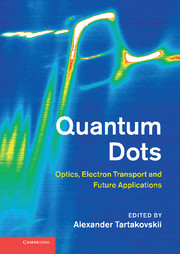Book contents
- Frontmatter
- Contents
- List of contributors
- Preface
- Part I Nanostructure design and structural properties of epitaxially grown quantum dots and nanowires
- Part II Manipulation of individual quantum states in quantum dots using optical techniques
- Part III Optical properties of quantum dots in photonic cavities and plasmon-coupled dots
- Part IV Quantum dot nano-laboratory: magnetic ions and nuclear spins in a dot
- 12 Dynamics and optical control of an individual Mn spin in a quantum dot
- 13 Optical spectroscopy of InAs/GaAs quantum dots doped with a single Mn atom
- 14 Nuclear spin effects in quantum dot optics
- Part V Electron transport in quantum dots fabricated by lithographic techniques from III–V semiconductors and graphene
- Part VI Single dots for future telecommunications applications
- Index
- References
14 - Nuclear spin effects in quantum dot optics
from Part IV - Quantum dot nano-laboratory: magnetic ions and nuclear spins in a dot
Published online by Cambridge University Press: 05 August 2012
- Frontmatter
- Contents
- List of contributors
- Preface
- Part I Nanostructure design and structural properties of epitaxially grown quantum dots and nanowires
- Part II Manipulation of individual quantum states in quantum dots using optical techniques
- Part III Optical properties of quantum dots in photonic cavities and plasmon-coupled dots
- Part IV Quantum dot nano-laboratory: magnetic ions and nuclear spins in a dot
- 12 Dynamics and optical control of an individual Mn spin in a quantum dot
- 13 Optical spectroscopy of InAs/GaAs quantum dots doped with a single Mn atom
- 14 Nuclear spin effects in quantum dot optics
- Part V Electron transport in quantum dots fabricated by lithographic techniques from III–V semiconductors and graphene
- Part VI Single dots for future telecommunications applications
- Index
- References
Summary
Introduction
This chapter is devoted to the description of the interaction of polarized light with carrier spins and nuclear spins in semiconductor quantum dots. A historical starting point of these original experiments is the close analogy between quantum dot physics and atomic physics. In 1952, Brossel Kastler and Winter investigated mercury atoms in a weak magnetic field which splits the electron Zeeman levels. By irradiation of the atoms with circularly polarized light the authors could selectively populate one of the electron Zeeman levels [9]. This process has since been referred to as optical pumping. Soon afterwards the first optical pumping of carrier spins in a semiconductor was reported [31]. The initial pumping of spin-orientated conduction electrons in silicon induced by polarized light led to polarization of the nuclear spins of the atoms of the silicon lattice via the hyperfine interaction. This dependence of the nuclear magnetization on the polarization of the absorbed light is at the heart of the experiments described in this chapter. A review of the nuclear spin effects in bulk semiconductors can be found in [37]. The hyperfine interaction between carrier and nuclear spins gives even more spectacular results in quantum dots as shown in pioneering work on optically detected nuclear magnetic resonance ODNMR [23] and orientation of one spin species will have a strong influence on the other [25, 7]. Below we detail a selection of the most remarkable consequences of nuclear spin physics on the optical properties of quantum dots.
- Type
- Chapter
- Information
- Quantum DotsOptics, Electron Transport and Future Applications, pp. 237 - 252Publisher: Cambridge University PressPrint publication year: 2012
References
- 1
- Cited by



